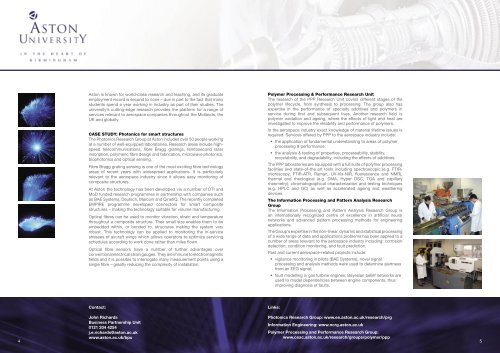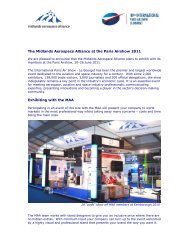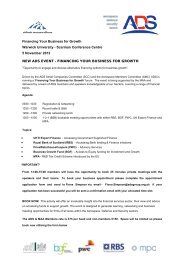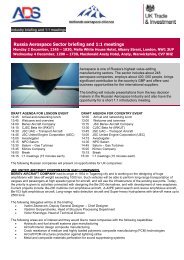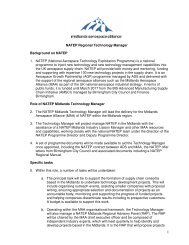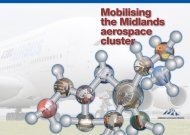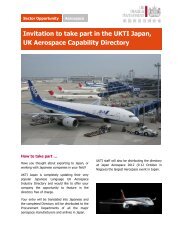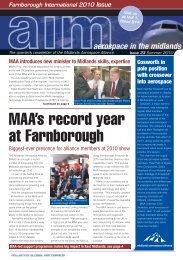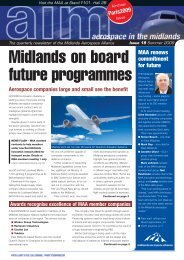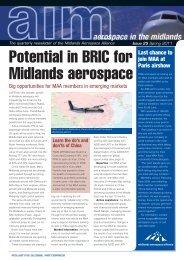new technology for aerospace
here - Midlands Aerospace Alliance
here - Midlands Aerospace Alliance
You also want an ePaper? Increase the reach of your titles
YUMPU automatically turns print PDFs into web optimized ePapers that Google loves.
Aston is known <strong>for</strong> world-class research and teaching, and its graduate<br />
employment record is second to none – due in part to the fact that many<br />
students spend a year working in industry as part of their studies. The<br />
university’s cutting-edge research provides the plat<strong>for</strong>m <strong>for</strong> a range of<br />
services relevant to <strong>aerospace</strong> companies throughout the Midlands, the<br />
UK and globally.<br />
CASE STUDY: Photonics <strong>for</strong> smart structures<br />
The Photonics Research Group at Aston includes over 50 people working<br />
at a number of well-equipped laboratories. Research areas include highspeed<br />
telecommunications, fibre Bragg gratings, femtosecond laser<br />
inscription, polymeric fibre design and fabrication, microwave photonics,<br />
biophotonics and optical sensing.<br />
Fibre Bragg grating sensing is one of the most exciting fibre <strong>technology</strong><br />
areas of recent years with widespread applications. It is particularly<br />
relevant to the <strong>aerospace</strong> industry since it allows easy monitoring of<br />
composite structures.<br />
At Aston the <strong>technology</strong> has been developed via a number of DTI and<br />
MoD funded research programmes in partnership with companies such<br />
as BAE Systems, Deutsch, Marconi and QinetiQ. The recently completed<br />
EMPIRE programme developed connectors <strong>for</strong> smart composite<br />
structures – making the <strong>technology</strong> suitable <strong>for</strong> volume manufacturing.<br />
Optical fibres can be used to monitor vibration, strain and temperature<br />
throughout a composite structure. Their small size enables them to be<br />
embedded within, or bonded to, structures making the system very<br />
robust. This <strong>technology</strong> can be applied to monitoring the in-service<br />
stresses of aircraft wings which allows operators to optimize servicing<br />
schedules according to work done rather than miles flown.<br />
Optical fibre sensors have a number of further advantages over<br />
conventional electrical strain gauges. They are immune to electromagnetic<br />
fields and it is possible to interrogate many measurement points using a<br />
single fibre – greatly reducing the complexity of installation.<br />
Polymer Processing & Per<strong>for</strong>mance Research Unit<br />
The research of the PPP Research Unit covers different stages of the<br />
polymer lifecycle, from synthesis to processing. The group also has<br />
expertise in the per<strong>for</strong>mance of specialty additives and polymers in<br />
service during first and subsequent lives. Another research field is<br />
polymer oxidation and ageing, where the effects of light and heat are<br />
investigated to improve the reliability and per<strong>for</strong>mance of polymers.<br />
In the <strong>aerospace</strong> industry exact knowledge of material lifetime issues is<br />
required. Services offered by PPP to the <strong>aerospace</strong> industry include:<br />
• the application of fundamental understanding to areas of polymer<br />
processing & per<strong>for</strong>mance;<br />
• the analysis & testing of properties, processability, stability,<br />
recyclability, and degradability, including the effects of additives.<br />
The PPP laboratories are equipped with a full suite of polymer processing<br />
facilities and state-of-the art tools including spectroscopic (e.g. FTIRmicroscopy,<br />
FTIR-ATR, Raman, UV-Vis-NIR, fluorescence and NMR),<br />
thermal and rheological (e.g. DMA, Hyper DSC, TGA and capillary<br />
rheometry), chromatographical characterization and testing techniques<br />
(e.g. HPLC and GC) as well as accelerated ageing and weathering<br />
devices.<br />
The In<strong>for</strong>mation Processing and Pattern Analysis Research<br />
Group<br />
The In<strong>for</strong>mation Processing and Pattern Analysis Research Group is<br />
an internationally recognized centre of excellence in artificial neural<br />
networks and advanced pattern processing methods <strong>for</strong> engineering<br />
applications.<br />
The Group’s expertise in the non-linear, dynamic and statistical processing<br />
of a wide range of data and applications problems has been applied to a<br />
number of areas relevant to the <strong>aerospace</strong> industry including: corrosion<br />
detection; condition monitoring, and fault prediction.<br />
Past and current <strong>aerospace</strong>-related projects include:<br />
• vigilance monitoring in pilots (BAE Systems); novel signal<br />
processing and analysis methods were used to determine alertness<br />
from an EEG signal;<br />
• fault modelling in gas turbine engines; Bayesian belief networks are<br />
used to model dependencies between engine components, thus<br />
improving diagnosis of faults.<br />
Contact:<br />
Links:<br />
4<br />
John Richards<br />
Business Partnership Unit<br />
0121 204 4254<br />
j.e.richards@aston.ac.uk<br />
www.aston.ac.uk/bpu<br />
Photonics Research Group: www.ee.aston.ac.uk/research/prg<br />
In<strong>for</strong>mation Engineering: www.ncrg.aston.ac.uk<br />
Polymer Processing and Per<strong>for</strong>mance Research Group:<br />
www.ceac.aston.ac.uk/research/groups/polymer/ppp<br />
5


